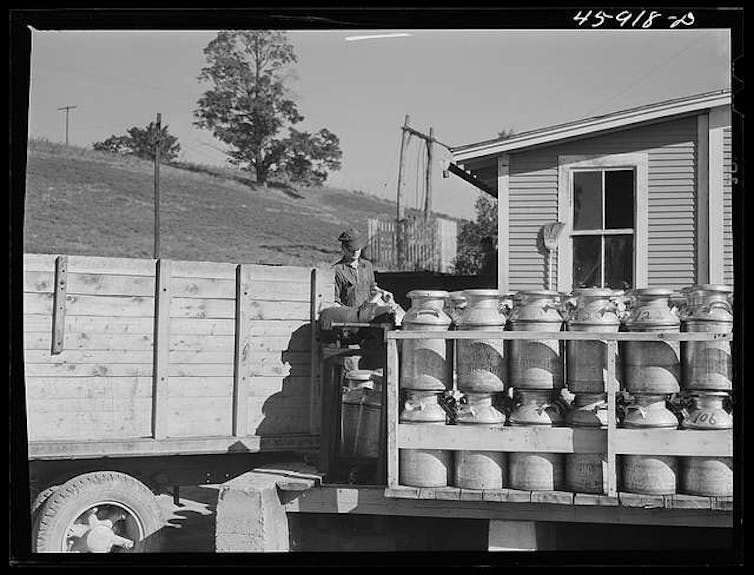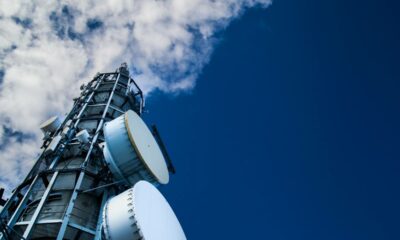
steverts, iStock /Getty Images Plus
Kerry E. Kaylegian, Penn State
As the H5N1 avian flu virus continues to spread in poultry flocks and dairy cattle, consumers may worry about whether the U.S. milk supply is safe to drink. According to the U.S. Food and Drug Administration, the answer is yes, as long as the milk is pasteurized.
In late November 2024, however, California regulators recalled two batches of raw, unpasteurized milk from a Fresno dairy farm after bird flu virus was detected in the milk. The dairy subsequently recalled all of its raw milk and cream products from stores due to possible bird flu contamination. State regulators placed the farm under quarantine, suspending any new distribution of its raw milk, cream, kefir, butter and cheese products produced on or after November 27.
No human bird flu cases associated with the milk were detected immediately following the recalls. But officials strongly urged buyers not to drink raw milk from the affected batches and to return it to the store where they bought it.
Despite health experts’ warning that raw milk could contain high levels of the avian flu virus, along with many other pathogens, raw milk sales are up in the U.S. Robert F. Kennedy Jr., whom President-elect Donald Trump has said he will nominate to head the Department of Health and Human Services, has asserted that raw milk “advances human health,” contrary to warnings from FDA officials and food scientists.
As an extension food scientist in a state where raw milk sales are legal, I provide technical support to help processors produce high-quality, safe dairy foods. I also like to help people understand the confusing world of pasteurization methods on their milk labels, and why experts strongly discourage consuming raw milk and products made from it.
What can make milk unsafe
Dairy products, like many foods, have inherent risks that can cause a variety of illnesses and even death. Dairy milk comes from animals that graze outdoors, live in barns and lie in mud and manure. Milk is picked up from the farm in tanker trucks and delivered to the processing plant. These environments offer numerous opportunities for contamination by pathogens that cause illness and produce organisms that make food spoil.
For example, listeria monocytogenes comes from environmental sources like soil and water. Mild infections with listeriosis cause flu-like symptoms. More serious cases are, unfortunately, too common and can cause miscarriages in pregnant women and even death in extreme cases.
Other pathogens commonly associated with dairy animals and raw milk include E. coli, which can cause severe gastrointestinal infections and may lead to kidney damage; Campylobacter, the most common cause of diarrheal illness in the U.S.; and Salmonella, which cause abdominal pain, diarrhea and other symptoms.

Keeping beverages safe with heat
In the 1860s, French microbiologist Louis Pasteur discovered that heating wine and beer killed the organisms that caused spoilage, which then was a significant problem in France.
This heating process, which became known as pasteurization, was adopted in the U.S. prior to World War II, at a time when milk was responsible for 25% of all U.S. outbreaks of foodborne illnesses. In 1973 the federal government required that all milk sold across state lines in the U.S. had to be pasteurized, and in 1987 it banned interstate sales of raw milk.
Pasteurization heats every particle of a food to a specific temperature for a continuous length of time in order to kill the most heat-resistant pathogen associated with that product. Different organisms have different responses to heat, so controlled scientific studies are required to determine what length of time at a given temperature will kill a specific organism.
Since 1924, pasteurization in the U.S. has been guided by the Grade “A” Pasteurized Milk Ordinance, a federal guidance document that is updated every two years to reflect current science and has been adopted by all 50 states. Pasteurization equipment in the U.S. must meet stringent requirements that include sanitary design, safety controls and material standards.

Jack Delano, FSA/Library of Congress
Pasteurization methods
Dairy processors can choose among several different types of pasteurization. When executed properly, all of these methods produce the same result: pathogen-free milk. Processors may treat milk beyond minimum times or temperatures to provide an extra margin of safety, or to reduce bacteria that can cause milk to spoil, thus increasing the product’s shelf life.
Smaller-scale processors who handle limited volumes use what are known as vat pasteurizers, also known as batch pasteurizers. Milk is pumped into a temperature-controlled tank with a stirrer, heated to a minimum of 145 degrees Fahrenheit (63 Celsius) and held there continuously for 30 minutes. Then it is cooled and pumped out of the vat.
The most common method used for commercial milk is high-temperature short-time pasteurization, which can treat large volumes of milk. Milk is pumped through a series of thin plates at high speed to reach a minimum temperature of 161 F (71 C). Then it travels through a holding tube for 15 seconds, and the temperature is checked automatically for safety and cooled.
The most complex and expensive systems are ultra-pasteurizers and ultra-high-temperature pasteurizers, which pasteurize milk in just a few seconds at temperatures above 285 F (140 C). This approach destroys many spoilage organisms, giving the milk a significantly longer shelf life than with other methods, although sometimes products made this way have more of a “cooked” flavor.
Ultra-high-temperature products are processed in a sterile environment and packaged in sterile packaging, such as lined cartons and pouches. They can be shelf-stable for up to a year before they are opened. Ultra-high-temperature packaging makes taking milk to school for lunch safe for kids every day.
Avian flu in milk
The detection of avian flu virus fragments in milk is a new challenge for the dairy industry. Scientists do not have a full picture of the risks to humans but are learning.

Research so far has shown that virus particles end up in the milk of infected cows, but that pasteurization will inactivate the virus. The FDA advises consumers not to drink raw milk because there is limited information about whether it may transmit avian flu.
The agency also is urging producers not to manufacture or sell raw milk or raw milk products, including cheese, made with milk from cows showing symptoms of illness.
Avian flu continues to appear in new species, and as of early December 2024, 57 human cases had been confirmed in the U.S. Of these, all but two were people who worked with livestock.
Two recent cases – a child in California and a teen in Canada – may indicate that young people with immature immune systems are more vulnerable than adults to the virus. With medical researchers still learning how H5N1 is transmitted, I agree with the FDA that raw milk poses risks not worth taking.
This is an updated version of an article originally published on May 17, 2024.![]()
Kerry E. Kaylegian, Associate Research Professor of Food Science, Penn State
This article is republished from The Conversation under a Creative Commons license. Read the original article.






























































